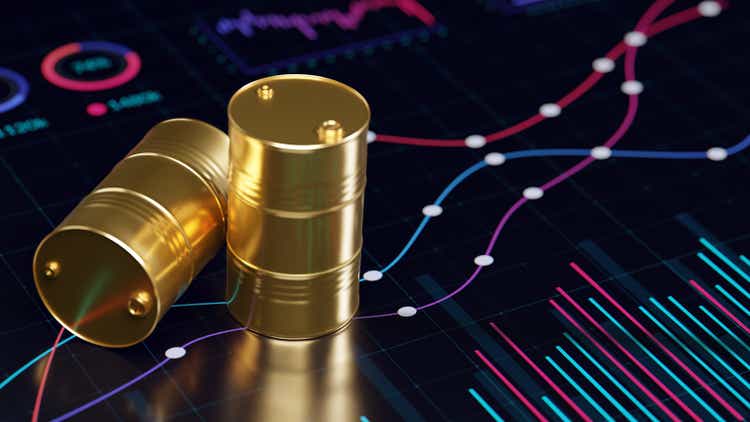sankai/iStock via Getty Images
There are many perspectives in the investor universe and I enjoy reading about others with a different approach to investment. A dividend approach is very popular with Seeking Alpha readers. The recent spike in gasoline prices has provided investors with an opportunity to invest in Global Partners LP (NYSE:GLP) to achieve a high dividend yield. On the face of it, Global Partners sits in a sweet spot because it has an extensive gasoline distribution network and also controls a wide convenience store network associated with pumping gas. Here I provide another way of looking at the problem of gasoline prices and how the gasoline gets delivered to independent networks, that suggests that a GLP dividend investment may not be as safe as one might anticipate. As always, the devil is in the detail and investment timing is a core part of the equation.
What is the Global Partners LP doing about electrification?
The Q&A of quarterly earnings is always the place where you get a sense of how management views change and the Q4 2021 call for Global Partners is a good example. In response to a question about appointment of an Electric Innovation Strategist, it was clear that management is thoughtful about the transition, but is looking to Government to help in funding establishment of charging sites. The short answer is that GLP’s GDSO portfolio consists of 1,595 sites and the company has been awarded funds to install charging stations at 9 of their sites. The revealing bit was that CEO Eric Slifka moved his response to the question about electrification to a more general view about terminalling and different fuels. Management clearly has a fuel-centric view of energy, while the world is electrifying. Note that the Biden Administration is paying attention to BEV charging, with plans for substantial spend ($7.5 billion) dedicated to building national charging infrastructure.
Refuelling an ICE is a way to capture further business from a car owner and GLP does this well. My understanding is that many BEV owners are very happy to no longer need to worry about refuelling because they just plug in when they get home. This leaves open whether GLP businesses are going to remain BEV customers. The point is that a fast charger is different to filling a tank with gasoline. Time will tell if the convenience store attached to a filling station is going to be a successful business model going forward. I think public charging stations are likely to be more attractive to customers of shopping centers, where a stay of more than a few minutes is warranted, than a convenience store.
It is clear that GLP thinks that there is not going to be a major change from pumping gasoline for the foreseeable future. This would form the basis for dividend investment.
How much change is needed to impact GLP’s business?
Markets respond long before a change is fully implemented. Sceptics of electrification love to cite statistics about low numbers of electric vehicles and invariably revert to a suggestion that the shift will take forever. So the argument is not to worry about these transitions.
Two things focus my mind. Firstly, the speed of transitions is astonishing when they happen. The complete switch from horse and cart to motorised transport happened in not much more than a decade. We are already well into the start of BEV adoption. Tesla (TSLA) will sell ~1.5 million vehicles this year. The Biden Administration’s goal is for BEVs to comprise 50% of vehicle sales in the US by 2030, and global BEV sales will be above 10% in 2022. Secondly, you don’t need full adoption to mess with an industry. Oil prices change dramatically on single-digit % changes in supply and demand.
Dividend investment takes time because your 8.7% dividend takes a year to be earned.
It is all about timing
To be comfortable about dividend investment in Global Partners, an investor needs to ignore/discount the relevance of structural change in the transport industry. If there is no threat of change, it would follow that there would be steady money to be made from a big short-term upwards shift in gasoline prices.
My point is that a happy dividend investment needs time to be realised and at the end of your investment period, you need to be able to exit the stock in a way that doesn’t negatively impact the gains from the dividends. I’m convinced that there is going to be an end to pumping gasoline, so a dividend investor will exit GLP at some stage, unless the company radically changes its business.
So the question is about timing. My take, based on the switch from horse and cart and the iPhone, is that the window is much shorter than dividend investors assume. I’m not the investor here, so the chore for you and your financial advisor is to decide about the timing issue, because it is surely relevant.
It is about making money
So my question is: “Does an 8.7% dividend, that might only last a year or two, justify locking away a fair chunk of capital that might be worth considerably less when you exit?”
Conclusion
I’m a dividend investor’s nightmare because I thrive on change and look for opportunities that provide major capital appreciation. This is not for the faint hearted and usually means backing one’s research against the mainstream. It works for me, but it is hard work.
I’m not saying don’t consider a dividend investment in Global Partners, but I do say it is worth you and your financial advisor at least taking into account that the world is changing fast and that this is going to impact dividend investors too whether you like it or not. I’m not a financial advisor but I do a lot of research into how to make a buck. I hope that my comments help you and your advisor as you chart these perilous times.


Be the first to comment